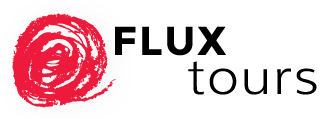Experienced FLUX-tourist with favorite activities for each region she visits, such as: Taking endless strolls out of curiosity through supermarkets and malls in foreign countries. Euphorically ordering exotic dishes in small, unflashy snack bars. Sitting around in public places and – perfectly disguised through inconspicuous behavior like reading or eating – studying people. She has much compressed her luggage over time; nevertheless, a pair of sun glasses and an insect repellent have to be in her bag! An old T4 being her favorite means of transport, it always stops along the way and allows her to open the black door of its trailer…
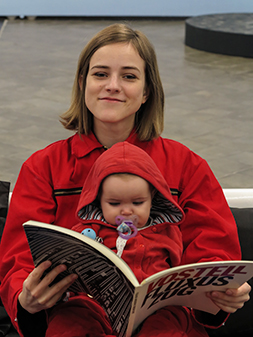
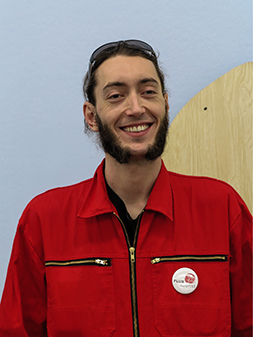
Bummer, dreamer and motorised miles collector. Favors flat land which is slightly too warm and windless for locomotion. Nevertheless living near the coast for good reason… Enjoys travelling from one place to another more than actually being in one of them and is, at all times enjoying sensory experience. Being a vagabond, he is out and about in disciplines crossing his way; sometimes heading here, there, and everywhere for this and that.
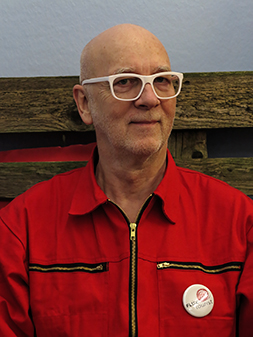
Seeman, nomad of the arts, lover of clear water and warm oceans especially if surrounded by mountains; métier: long-distance journeys right here and right now – whersoever.
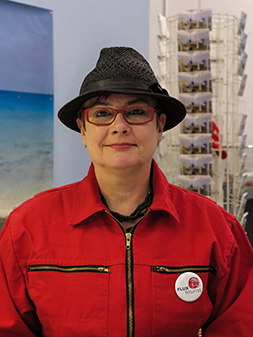
Well-versed FLUX-tourist; does regularly suffer from the travel bug and passes it on to the travel partner straight away; counteractions: letting her finger travel on the tourist map, slide shows with prawn cocktails, swinging her hips for several minutes to salsa or – if all else fails – taking off with the paper aeroplane.
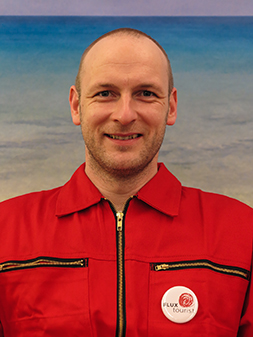
Loves nothing better than journeys to the cellar or the to the attic, strolls around the block or to the construction site around the corner. Searching for paths offside the main streets and short cuts leading through garages and gardens; hiking up and down the island of Rügen’s coast, gathering driftwood in Portugal, attempted to ride the bike to North Cape but only made it half, but fully to Paris still on bike, was camping on the roundabout in Versailles until the police and rain came, sailed around the island of Hiddensee and through the Öresund under heavy fog, can stand upright on a surfboard – only shortly on water, better sliding down the hill, did later fly to the land of the rising sun and the permanent smile, trip of a lifetime: Iceland
FLUX-tours ambulant pulls up with the black egg and invites you to a 4’33 action.
FLUX-tours ambulant, with its mobile art rooms and action rooms, pulls up at Ziegenmarkt in the city of Schwerin. From 2 p.m. to 6 p.m.: actions in public place and from 8 p.m. to 10 p.m.: FLUX-tours Lounge.
FLUX-tours ambulant, with its mobile art rooms and action rooms, pulls up at Großer Dreesch in the city of Schwerin. From 2 p.m. to 6 p.m.: actions in public place. The planned FLUX-tours Lounge from 8 p.m.to 10 p.m. will not take place due to bad weather conditions.
FLUX-tours ambulant, with its mobile art rooms and action rooms, pulls up at the Stadthafen in the city of Rostockand meets the FiSH-(short film) Festival. From 2 p.m. to 6 p.m.: actions in public place and from 8 p.m. to 10 p.m.: FLUX-tours Lounge (depending on weather conditions).
FLUX-tours ambulant, with its mobile art rooms and action rooms, pulls up at Neuer Markt in the city of Stralsund. From 2 p.m. to 6 p.m.: actions in public place and from 8 p.m. to 10 p.m.: FLUX-tours Lounge (depending on weather conditions).
FLUX-tours ambulant, with its mobile art rooms and action rooms, pulls up in front of the Pommersches Landesmuseum in the city of Greifswald. From 2 p.m. to 6 p.m.: actions in public place and from 8 p.m. to 10 p.m.: FLUX-tours Lounge (depending on weather conditions).
Why not use blenders, pots, water kettles, hair-dryers and other “junk” to create noises and turn those into a piece of music (John Cage)? Why not cut up a piano on stage (Dick Higgins and other activists)? Why not piece together large trash and scrap to a sculpture instead of discarding it inconsiderately (Robert Filliou and Jean Tinguely, for instance)? Why not examine the acts of peeling a potato or sweeping a square as a sculptural practice (Joseph Beuys)? Why not seek beauty in the gutter – to involve French Romanticism as instigation (Charles Baudelaire)? And why not “give the commoner an elevated mind, the ordinary a mysterious appearance, the familiar the dignity of the unknown, the finite an illusion of the infinite”? says the old – and obviously still valid – basic programme of Novalis, one of the leading figures in German Romanticism.3 So why not use the aesthetic peculiarities of everyday materials, everyday procedures and everyday situations as an opportunity to contemplate these artistically, as well as experiment with these and accredit their artistic worthiness and artistic faculty? With those and similar questions and respective answers did the transatlantic art movement “FLUXUS” raise some attention in the sixties of the last century. It continued and brought to a head what other ‘art revolutionaries’ thought and did before that, what was in the wind in the sixties in the last century and what is still alive in the high cultures subcultures of today. Fluxus or the activists of the “Situationist International”, for instance, supported, went along with and shaped the rebellion against “the fustiness of 1,000 years” under “the gowns”4 here and elsewhere – the awakening and uproar of the so-called ’68 generation and likewise malcontented in Europe and North America.
The Fluxus movement demonstrated in a blunt way how art by “ingenious amateurs” “without any talent” whatsoever5, and without any artistic “geek-ism” could look like. Instead, they performed critique on art and society with ruse, courage, impertinence and irony. All that with the intention of debunking the so far hidden and the thoughtless, by employing “anti-artistic” tools to take artistic action and cast off fixed technical traditions and thought patterns. EXIT! The artist Wolf Vostell boiled the Fluxus concept down to an essence: “Art = Life, Life = Art”.
Read more: (opens PDF: “FLUXUS, FLUX-tours: EXIT” text by Ulrich Puritz, text only available in German)


